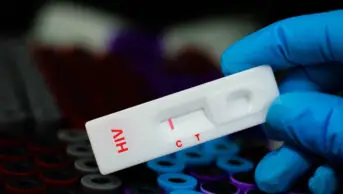Outpatient parenteral antimicrobial therapy (OPAT) is a method by which IV antimicrobials are administered to patients in the community. Without an OPAT service, these patients would otherwise remain in hospital when deemed medically fit to be treated in the community setting. OPAT has the potential to reduce bed pressures, NHS costs and improve the quality of patient care[1,2].
The Southern Health and Social Care Trust (SHSCT) OPAT team consists of a team of microbiology consultants, antimicrobial pharmacists and IV nurse coordinators. The OPAT team carry out bedside reviews of each potential OPAT patient to ensure a clinical plan to support the patient is in place. These bedside reviews provide the opportunity to review the patient’s therapy and decide upon the most appropriate treatment choice. This includes the option to plan for IV antimicrobials at home and to switch from IV to oral therapies[3]. Once discharged from hospital OPAT patients are monitored at a weekly multidisciplinary team (MDT) meeting and reviewed at fortnightly patient clinics.
Information for OPAT patients is documented throughout their journey, including demographics, antimicrobials used, outcomes and adverse events. The SHSCT OPAT team treated 200 patients during 2021/2022 with IV and oral antimicrobials. Patients receiving either their IV antimicrobials in the community and those switched to oral therapies received a total of 4,393 days treatment. If these courses of antimicrobials had been received in hospital they would have equalled 12 bed days per day. Of these 200 patients, 24 (12%) experienced an adverse event (unpublished in-house data).
All patients have the potential to experience adverse events when receiving antimicrobials; hospital patients have the advantage of care 24 hours per day. However, as OPAT patients receiving IV antimicrobials are seen by a nurse daily and all patients are provided with contact numbers to provide safety netting, in addition to the fact these patients are well enough to be discharged from hospital, it is felt that the benefits of being treated at home outweigh the risks[4]. While these adverse events could be attributed to polypharmacy and comorbidities, the events documented happened while the patient was receiving an antimicrobial; therefore, a clinical decision was made to attribute the antimicrobial as the cause. All adverse events encountered could be expected and are listed within product literature as being associated with the antimicrobial[5–15].
There were a variety of adverse events experienced by patients treated by the OPAT team, with the most common antimicrobial to cause an adverse event being ceftriaxone. However, ceftriaxone is the most commonly used antimicrobial by the OPAT team (58%; n=73). Seven patients receiving ceftriaxone experience blood dyscrasias (six with a low white cell count, one with increased eosinophils and a rash), one patient had clostridium difficile and one patient had a swollen arm, query clot. Linezolid caused blood dyscrasias (deranged liver function tests and low platelets) in two patients and a rash in two patients. Ertapenem caused one patient to fall, clostridium difficile in one patient and a rash in one patient. A combination of levofloxacin and rifampicin caused vomiting in one patient and diarrhoea in another. Piperacillin/tazobactam raised the eosinophils in one patient. Meropenem and voriconazole both caused deranged liver function tests in one patient each while a combination of teicoplanin and rifampicin caused low platelets. Daptomycin raised a patient’s creatine kinase and one patient suffered nausea on tigecycline. No patients died or were admitted to hospital as a result of these events. All adverse events were managed by the OPAT team. The decisions were either to switch to an alternative antimicrobial or stop antimicrobials if it was felt the patient had responded sufficiently to treatment at the point of the adverse reaction.
Research has shown 18% of OPAT patients experience adverse events while receiving OPAT therapy[16]. We found 12% of our patients experienced an adverse event, with more adverse events reported with IV antimicrobial use than oral use. One reason may be that patients at home on oral therapies may have discussed adverse events, such as nausea, with their own GP, who is likely to have prescribed antiemetic, and the patient subsequently completed their antimicrobial course. As patients receiving IV antimicrobials are seen by a nurse daily, this may also prompt reporting of adverse events.
Following on from these observations, we intend to enhance contact with our patients receiving complex oral therapies to improve ongoing monitoring. This will take the form of increased clinic reviews, either in person or via telephone. As we found that over one tenth of our patients experienced an adverse event while receiving antimicrobials when managed by our OPAT team, we feel it is vital to maintain strong communication links and ensure close monitoring. This allows early identification of adverse events, timely intervention and prevents readmission to hospital[16].
Peter McKee, Geraldine Conlon-Bingham, Lisa Lennon, Jessie McNally, Orla McGivern, Claire McMurray, and Tiffany Ki are all antimicrobial pharmacists at Southern Health and Social Care Trust; Pauline Curran and Susan Mayne are both intravenous nurse co-ordinators at Southern Health and Social Care Trust; Alan Wu, Declan Crilley and Kevin Lewis are all microbiology specialty doctors at Southern Health and Social Care Trust; Angel Boulos, Cara McKeating, Claire Donnelly, Oystein Johansen and Sara Hedderwick are all consultant microbiologists at Southern Health and Social Care Trust.
- 1Berrevoets MAH, Oerlemans AJM, Tromp M, et al. Quality of outpatient parenteral antimicrobial therapy (OPAT) care from the patient’s perspective: a qualitative study. BMJ Open. 2018;8:e024564. doi:10.1136/bmjopen-2018-024564
- 2Tice AD, Rehm SJ, Dalovisio JR, et al. Practice Guidelines for Outpatient Parenteral Antimicrobial Therapy. Clinical Infectious Diseases. 2004;38:1651–71. doi:10.1086/420939
- 3Switching patients from IV to oral antimicrobials. Pharmaceutical Journal. 2023. doi:10.1211/pj.2023.1.180821
- 4Arsenault-Lapierre G, Henein M, Gaid D, et al. Hospital-at-Home Interventions vs In-Hospital Stay for Patients With Chronic Disease Who Present to the Emergency Department. JAMA Netw Open. 2021;4:e2111568. doi:10.1001/jamanetworkopen.2021.11568
- 5Ceftriaxone 2g powder for solution for injection vials. Medicines Complete. https://www.medicines.org.uk/emc/product/8768/smpc (accessed Jun 2023).
- 6Linezolid 600mg Film-Coated Tablets. Medicines Complete. https://www.medicines.org.uk/emc/product/10239 (accessed Jun 2023).
- 7Ertapenem 1g Powder for Concentrate for Solution for Infusion. Medicines Complete. https://www.medicines.org.uk/emc/product/11161/smpc (accessed Jun 2023).
- 8Levofloxacin 500mg tablets. Medicines Complete. https://www.medicines.org.uk/emc/product/12153/smpc (accessed Jun 2023).
- 9Rifampicin 300 mg Capsules. Medicines Complete. https://www.medicines.org.uk/emc/product/8789 (accessed Jun 2023).
- 10Tazocin 4 g / 0.5 g powder for solution for infusion. Medicines Complete. https://www.medicines.org.uk/emc/product/1267/smpc (accessed Jun 2023).
- 11Voriconazole 200 mg Tablets. Medicines Complete. https://www.medicines.org.uk/emc/product/7981/smpc (accessed Jun 2023).
- 12Meropenem 1 g powder for solution for injection or infusion. Medicines Complete . https://www.medicines.org.uk/emc/product/5067/smpc (accessed Jun 2023).
- 13Teicoplanin 400mg powder for solution for injection/infusion or oral solution. Medicines Complete. https://www.medicines.org.uk/emc/product/14611/smpc (accessed Jun 2023).
- 14Daptomycin 500 mg powder for solution for injection or infusion. Medicines Complete. https://www.medicines.org.uk/emc/product/14666/smpc (accessed Jun 2023).
- 15Tigecycline 50 mg powder for solution for infusion. Medicines Complete. https://www.medicines.org.uk/emc/product/9232/smpc (accessed Jun 2023).
- 16Keller SC, Williams D, Gavgani M, et al. Rates of and Risk Factors for Adverse Drug Events in Outpatient Parenteral Antimicrobial Therapy. Clinical Infectious Diseases. 2017;66:11–9. doi:10.1093/cid/cix733

